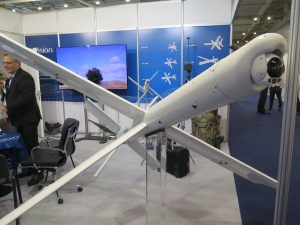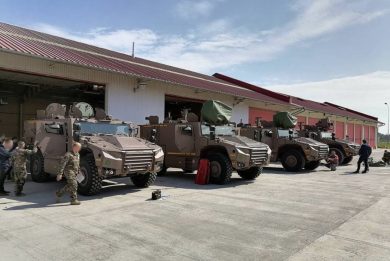
Defence exhibitions: DEFEA, Greece back on stage
By Joseph Roukoz
After 13 years Greece has again its defence exhibition: On July 13th the Greek Minister of Defense Mr. Nikôlaos Panagiotopoulos accompanied by Greek officials as well as foreign military delegations, inaugurated the first edition of DEFEA (DEFence Exhibition Athens), which takes place at the Metropolitan Expo exhibition centre, located at Athens International Airport.

Organized by ROTA Exhibitions Greece, under the auspices of the Ministry of Defense-General Directorate of Defense Investments and Armaments (GDDIA) with the support of the Association of Hellenic Manufacturers of Defense Material, DEFEA is a tri-service exhibition hence land-, naval- and air-related systems are exhibited.
Beside the exhibition, a series of conferences and seminars were organised, hosted in the two conference rooms available at the venue.
Overall more than 300 exhibitors representing over 20 countries gathered at the Metropolitan Expo exhibition centre to propose their weapon systems and equipment. Beside the Hellenic defence industry, many defence companies from industrialised countries all around the world consider with interest the Greek market, as the country needs to modernise its armed forces. Following the acquisition of Dassault Rafale multirole fighters, it will be the turn of the Navy, decisions being expected next fall, the Army also needing to renovate its equipment. This might well explain the success of the first edition of DEFEA, the second edition being scheduled for May 9 to 11, 2023.
Exhibitors and their products were hosted in two main halls. Entering the first one the first sight was the stand of Hellenic Defense Systems S.A. that exhibited an upgraded version of the BMP1 fighting infantry vehicle. The company acquired the IFVs from the Greek Army and completely refurbished them, without carrying out any major modification. According to Hellenic Defense Systems, 70 such refurbished vehicles have been recently acquired by Egypt.
Although no specific requirement has yet emerged, Nexter of France exhibited in Athens a dedicated version of its VBCI named Philoctetes. Painted with the Greek Army colour scheme, it is fitted with the company T40 unmanned turret armed with the CTAI 40 mm gun using telescoped case ammunition on top of which we find a Kongsber RCWS armed with a 12.7 machine gun. On each side of the turret we find a single launcher for the 5th generation MMP missile from MBDA. To improve manoeuvrability the fourth axle is steerable, which allows reducing the turning radius.
Remaining in France, Arquus is present in Greece with over 240 VBL light armoured vehicles sold long time ago by then Panhard. These ageing vehicles need either to be upgraded or replaced, and Arquus is ready to propose both solutions, leveraging the work done on French Army VBLs or suggesting one of its products in that same category. As for unprotected troop transport and logistic purposes, it proposes the VLRA high mobility truck, available also in 6×6 configuration. The Trapper multirole platform, used by the French Army as liaison vehicle, is also proposed as light troop carrier.
The United States presence was quite massive. Among the many exhibitors, Oshkosh Defense was showing its JLTV, the armoured 4×4 high mobility vehicle which is becoming the standard in the US military and has already obtained considerable success on the export market, including Europe. Oshkosh also exhibited its FMTV in the cargo 6×6 version with a heavily armoured cabin. Both vehicles belonged to the Regimental Support Squadron of the US Army 2nd Cavalry Regiment based in Germany. An M1117 ASV by Textron Systems was also exhibited.
Although not an immediate requirement, in due time the Hellenic Army will have to replace its ageing G3 assault rifles. No requirements have been issued, and it is not known is the service will remain with the 7.62×51 mm calibre or will move to the smaller 5.56×45 mm, which in recent times is not so much appreciated by many armies. This replacement need explains the presence of numerous small arms manufacturers.
Among them FN Herstal of Belgium which proposes its SCAR-L MK2 and SCAR-H MK2 assault rifles, respectively in the lighter and heavier calibre. Both are available with barrels of different lengths, feature a folding buttstock and can be fitted with a 40 mm underbarrel grenade launcher.
The Air Force having satisfied its need for a new fighter with the acquisition of the French Rafale, the next service in line to modernise its assets is the Hellenic Navy, which has a requirement to replace its fleet of Hydra-class Meko 200HN frigates with a comprehensive programme including the procurement of four new frigates, the upgrading of the in service four Hydra-class frigates and a “stop-gap solution” for the urgent replacement need, including the procurement of second-hand vessels. The Greek Government also want to revitalize the local shipbuilding and naval industry with at least part of the production being taken locally. It is not surprising that a number of shipyards were exhibiting their proposals at DEFEA, a possible decision being expected for next fall according to rumours.
Fincantieri of Italy is proposing the FREMM multi-mission frigate in the ASW version already built for the Italian Navy, in a configuration that bests fits Greek Navy requirements. The combat system is expected to be based on the same Leonardo CMS and multi-function radar equipping the Italian Navy and export platforms in addition to an armament package based on MBDA missiles including Aster 15 and 30 hosted in a 16 cells Sylver vertical launch system for air defence, and Exocet MM40 Block 3. Artillery would be provided by Leonardo, in the form of two Oto Melara 76/62 mm Super Rapido capable to be equipped with Strales kit. Fincantieri would also upgrade in-service Meko 200 HN with an electronic and weapon package to offer communality with the new ships that are expected to be built at least partially in Greece. No further details were released, but a local strategic partnership with the today under-selling Hellenic Shipyards at Skaramangas is foreseen. Fincantieri is also offering second-hand ships previously in service with the Italian Navy.
Naval Group of France is offering its FDI (Frégate de Défense et d’Intervention) in the HN version ofwhich, according to the French shipbuilder, three would be built in Greece, the first-of-class to be built in France by 2025, along with a gap filler solution of two frigates available in early 2022; this goes along with the modernization of the Meko 200 HN in Greece and an ambitious Hellenic Industry Participation (HIP). At 4,500 tonnes displacement and 120 meters length, they are smaller than the FREMM but maintain anti-ship, air defence, anti-submarine warfare and special forces projection capabilities. Their combat system based on Thales Seafire four fixed faces radar and Naval Group new generation command management system features an armament package that includes Aster missiles or a combination of Aster and Mica NG missiles, 21 RAM, 8 Exocet MM40 Block 3, MU90 anti-submarine torpedoes, a 76/62 mm Super Rapido gun and 20mm remotely operated guns.
Damen shipyards is offering the new Sigma 11515 HN frigate design with a range of AAW, ASuW and ASW capabilities. With a 4,440 tonnes and 119 meters platform, the new design offer an integrated mast solution with air and surface four fixed faces radars and stealthy design based on Thales Nederland sensors suite and an armament package including a 16-cell Mk 41 VLS capable to fire up to 32 Raytheon ESSMs or a mix of Raytheon SM-2s and ESSMs, a RAM inner-layer defence system and a 76/62 mm Super Rapido gun, lightweight torpedo launchers and remotely controlled guns in addition to a suite of decoy launchers. All four Sigma 11515 HN frigates would be built in Greece, based on a domestic building and support package with local industry. The stop-gap solution is reported to be based on at least two second-hand Karel Doorman frigates and the upgrading of the in-service Hellenic Navy’s frigates.
Babcock of the UK is proposing the Arrowhead 140 frigate design in a customized version with the participation of Thales and MBDA UK for sensors and weapon systems The stop-gap solution is expected to be based on second-hand Type 23s.
The US Lockheed Martin is proposing four Hellenic Navy Future Frigates (HF2s) based on the company’s export Multi-Mission Surface Combatant (MMSC) and Freedom-class variant of the Littoral Combat Ship (LCS) built by Fincantieri Marinette Marine. The HF2 is expected to be armed with one Mk 41 VLS for ESSM and Standard, as well as a RAM inner-layer defence system and 76/62 Super Rapido gun all managed by the Lockheed Martin COMBATSS-21 CMS. The same systems are expected to be proposed for the upgrading of in-service frigates while LCSs planned to be decommissioned from the US Navy could be offered as gap-filler.
Israel was definitely one of the most represented nations at DEFEA, with Elbit Systems, Israel Aerospace Industries and Rafael among the leading companies. Due to the lack of exhibitions caused by the pandemics, DEFEA was one of the first chances to see in the Rafael stand the presence of Aeronautics, which since late 2019 has become a Rafael subsidiary bringing to the group its UAS capacity. In Athens the focus of its stand was the Orbiter 4, a 50 kg MTOW small tactical UAS capable to fly for over 24 hours with a 12 kg multiple payload, carrying out operations both on land an sea. Catapult-launched, it has a small logistic footprint and can be operated by a crew of three.
Specialised in the design and production of loitering munitions, UVision showcased its Hero-120, a medium-range system with anti-armour capability currently in competition for a US Army contract after having been selected by the US Marine Corps for its Organic Precision Fire Mounted programme. Its configuration has been refined over time to improve its performances and its compatibility for canister launch. For longer ranges Uvision proposes its Hero-400 EC, which depending on the data link adopted can reach up to 150 km. Uvision has developed multiple launchers for both systems.
The Russian presence was ensured by Rosoboronexport that exhibited in models the production of many of the Russian companies that fall under that organisation for exporting their production.
All in all DEFEA proved to be a good first, responding to exhibitors expectations, and will certainly allow organisers to get the lessons leraned needed to address some small organisational problems which are typical of a first-time event.
Photos courtesy J. Roukoz














